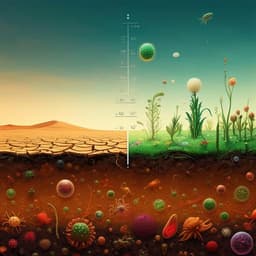
Environmental Studies and Forestry
Patterns in soil microbial diversity across Europe
M. Labouyrie, C. Ballabio, et al.
Discover how land-use disturbances influence microbial diversity and functioning across Europe in groundbreaking research by Maëva Labouyrie and colleagues. This study reveals critical insights that challenge our understanding of microbial ecosystems and environmental management, highlighting the need for a comprehensive approach to biodiversity monitoring.
~3 min • Beginner • English
Introduction
Soil biota underpin key ecosystem services including food production, climate regulation and pest control. Soil microbial communities regulate decomposition, carbon stocks, nutrient cycling and plant nutrient uptake, and changes in their composition and functions can alter these services. While land-use perturbation is known to reduce above-ground biodiversity and vegetation, climate and soil properties strongly shape above-ground communities, the impacts of anthropogenic and environmental factors on below-ground taxonomic and functional diversity at large (continental) scales are less understood. Prior work identified land-use perturbation as a major pressure on soil microbial diversity, alongside climate, soil properties (e.g., pH, texture, N availability) and vegetation. Plant community attributes and functional traits explain unique portions of variation in soil microbial diversity and composition. At the functional level, land-use and environmental factors can shift distributions of microbial groups (e.g., mycorrhizal fungi, pathogens). However, continental-scale, standardized assessments across both semi-natural (woodlands, grasslands) and highly managed (croplands) systems, comparing bacteria and fungi and examining interaction effects among drivers, are scarce. This study tests three hypotheses: (i) land-use perturbation affects soil microbial diversity, community structure and potential functional groups; (ii) bacterial and fungal guilds and functional groups are shaped by different forces; (iii) interactions between vegetation cover, climate and soil properties are more informative than single effects in explaining microbial communities and functions.
Literature Review
The paper synthesizes evidence that land-use intensification alters soil microbial community structure and that climate and soil properties (notably pH, texture, and nitrogen availability) influence microbial assemblages. It highlights findings that plant diversity and traits contribute uniquely to microbial diversity patterns. At functional levels, warming and humidity can elevate plant pathogens and reduce arbuscular mycorrhizal fungi, with soil properties (e.g., pH, C, N) shaping nutrient cycling groups. Prior large-scale studies often analyzed single domains or limited land-use types, seldom comparing bacteria and fungi simultaneously or spanning woodlands, grasslands, and croplands. Interaction effects among vegetation, climate, and soils have been largely overlooked, especially for functional groups, motivating a continental-scale, standardized analysis.
Methodology
Sampling and study design: As part of the 2018 LUCAS Soil module, 881 locations across the EU and UK were sampled; analyses focused on 715 sites distributed across Atlantic, Boreal, Continental and Mediterranean regions that included woodland, grassland and cropland covers. Vegetation cover types represented a gradient of land-use perturbation: coniferous forests, broadleaved forests, extensive grasslands, intensive grasslands, permanent crops, and non-permanent crops.
Soil and climate data: Soil physico-chemical properties measured (ISO methods) included pH (H2O), calcium carbonate, extractable K, available P, bulk density, clay, silt, coarse fragments, and C:N ratio. Climatic variables (WorldClim, 1970–2000 averages) included monthly mean air temperature, monthly aridity index (higher values = more humid), isothermality, temperature seasonality, annual temperature range, and precipitation seasonality.
DNA metabarcoding: Bacterial 16S rRNA gene amplified with primers 515F/926R (Illumina MiSeq, 2×300), and fungal ITS region with ITS9mun/ITS4ngsUni (PacBio Sequel II). Controls were included; subsets were resequenced to ensure adequate depth and reproducibility. Bacterial sequences were denoised to zero-radius OTUs (zOTUs/ASVs) using UPARSE; fungal sequences were clustered to 98% OTUs following Tedersoo et al. Bacterial taxonomy assigned with RDP (v16); fungal taxonomy with BLAST+ against UNITE 9.1.
Data processing and normalization: Non-target zOTUs (archaea, chloroplasts, mitochondria) were removed. Sites were filtered to ensure representation across land covers and sufficient reads; final normalization by Scaling with Ranked Subsampling (SRS) to 40,109 reads (bacteria) and 502 reads (fungi). Final datasets comprised 79,593 bacterial zOTUs and 25,962 fungal OTUs.
Functional annotation: Bacterial zOTUs were assigned functions via FAPROTAX (family/genus/species-level annotations) into groups: chemoheterotrophs, nitrogen fixers, and human pathogens. Fungal OTUs were assigned via FungalTraits/UNITE into ectomycorrhizal (EcM), arbuscular mycorrhizal fungi (AMF), saprotrophs, and plant pathogens. Proportions per site were calculated by read-count weighting.
Diversity metrics and community structure: Alpha-diversity measured as observed (z)OTU richness and Shannon index. Beta-diversity assessed using Bray–Curtis dissimilarity on Hellinger-transformed matrices, analyzed via distance-based RDA (dbRDA). Land-use effects tested by Kruskal–Wallis and pairwise Wilcoxon (BH correction); community differences by pairwise adonis (PERMANOVA).
Driver analyses: Single-effect multivariate OLS models with stepwise AIC feature selection assessed unique contributions (variation partitioning) of soil properties, climate, and vegetation cover to alpha- and beta-diversity and functional groups; variable importance statistics ranked predictors. Interaction-effect models included all two-way interactions among soil×vegetation, soil×climate, vegetation×climate; variation partitioning and model performance (adjusted R2, AIC) compared against single-effect models. Assumption checks included transformations, heteroscedasticity correction (sandwich estimator), and spatial autocorrelation diagnostics (variograms).
Key Findings
- Diversity patterns across land-use: Microbial richness and Shannon diversity were lowest in woodlands and significantly higher in grasslands and croplands. Vegetation cover significantly affected beta-diversity, with the largest compositional differences between croplands and woodlands (bacteria: R2=22.6%, F=123.26, p<0.001; fungi: R2=8.3%, F=38.05, p<0.001).
- Taxonomic composition: Bacteria spanned 23 phyla and 64 classes; most abundant phyla were Proteobacteria (30.6%), Actinobacteria (26.1%), Acidobacteria (22.9%). Fungi spanned 20 phyla and 75 classes; Ascomycota (49.3%) and Basidiomycota (34.1%) dominated. Shifts along the land-use gradient included increases in Actinobacteria, Ascomycota and certain classes from woodlands to grasslands/croplands, and decreases in Acidobacteria, Alphaproteobacteria, Basidiomycota and Agaricomycetes.
- Functional groups by vegetation cover:
• Bacterial chemoheterotrophs: 12,786 zOTUs (16.1% of bacterial zOTUs) dominating in croplands and intensive grasslands.
• Bacterial nitrogen fixers: 97 zOTUs (0.12%), more abundant in woodlands and extensive grasslands.
• Bacterial pathogens: 133 zOTUs (0.17%) dominant in coniferous forests.
• Ectomycorrhizal fungi: 2,361 OTUs (9.1%) dominant in woodlands, especially coniferous forests.
• Arbuscular mycorrhizal fungi (AMF): 1,261 OTUs (4.9%) more abundant in grasslands, particularly extensive.
• Fungal saprotrophs: 9,903 OTUs (35%) and fungal plant pathogens: 4,355 OTUs (16.8%) dominant in croplands and grasslands.
• Unassigned functions: 65,206 bacterial zOTUs (81.9%) and 7,642 fungal OTUs (29.4%) not assigned to functional groups.
- Single-effect drivers (variation partitioning):
• Alpha-diversity: Bacterial richness mainly by soil properties (14.5% unique variance), then climate (1.3%) and vegetation (0.6%). Fungal richness mainly by vegetation (5.1%), then soil (3.1%) and climate (0.6%).
• Beta-diversity: Soil properties most influential (bacteria 11.9% unique; fungi 2.5%); secondary drivers were climate for bacteria (3.1%) and vegetation for fungi (2.1%). Soil pH was the strongest soil predictor (alpha and beta), followed by C:N ratio.
- Functional group drivers (single-effects): Bacterial functional groups primarily driven by soil properties (chemoheterotrophs 7.7%; N-fixers 8.0%; pathogens 20.1% unique variance). Fungal functional groups primarily driven by vegetation cover (EcM 28.2%; AMF 17.0%; saprotrophs 11.9%; plant pathogens 12.0%).
- Environmental associations:
• Bacterial chemoheterotrophs: Associated with higher pH, lower C:N and CaCO3, higher bulk density and K, lower silt; favored by higher isothermality and larger annual temperature range; negatively related to higher aridity index (i.e., more humid conditions).
• N-fixing bacteria: Favored by lower pH, lower P, lower C:N, lower CaCO3 and silt, higher bulk density; climatically by higher isothermality, greater temperature seasonality, lower annual temperature range, lower air temperature and lower aridity index (colder, drier).
• Bacterial pathogens: Associated with sandy soils (low clay/silt), lower pH, higher CaCO3 and bulk density; favored by higher isothermality, higher air temperature, higher aridity index and greater temperature seasonality.
• EcM fungi: Linked to lower pH, lower P, higher coarse fragments; favored by more humid conditions (higher aridity index values).
• AMF: More abundant with lower K and coarse fragments, higher CaCO3 and clay; precipitation positively affected AMF; wider annual temperature range promoted AMF.
• Fungal saprotrophs: Favored by higher pH, bulk density, K, P, and lower CaCO3 and clay; hampered by more humid conditions.
• Fungal plant pathogens: Associated with sandy, higher pH soils, higher coarse fragments, lower P and CaCO3; wider temperature seasonality favored pathogens; precipitation positively affected pathogens.
- Interaction effects: Interactions involving vegetation cover were most relevant. Soil×vegetation interactions uniquely explained 4.8% (bacterial richness), 4.0% (fungal richness), and 2.8% (fungal Shannon). They explained major portions of beta-diversity (bacteria 17.3%; fungi 5.8%). Bacterial Shannon diversity was particularly affected by vegetation×climate interactions (3.4% unique). Interaction models improved explanatory power by 2–16% over single-effect models and were more parsimonious (lower AIC). Notably, the pH×temperature seasonality interaction strongly influenced fungal richness, diversity, and pathogen proportions, with effects varying across climatic clusters and vegetation types.
Discussion
Findings confirm that land-use perturbation shapes soil microbial diversity and community structure at continental scale, with croplands and grasslands harboring higher taxonomic richness and diversity than woodlands, and the strongest compositional contrasts occurring between woodlands and croplands. Functionally, managed systems are characterized by increased bacterial chemoheterotrophs and fungal saprotrophs and plant pathogens, whereas woodlands and extensive grasslands support more beneficial mutualists (EcM fungi, AMF) and N-fixing bacteria. These results indicate that increased taxonomic diversity in highly managed soils does not necessarily translate into beneficial ecosystem functions; rather, it can coincide with higher potential pathogenicity. Driver analyses show that bacterial diversity is predominantly governed by soil properties (especially pH and C:N), while fungal alpha-diversity aligns more with vegetation cover, reflecting strong plant–fungus linkages; beta-diversity for both domains is primarily structured by soil properties. Importantly, interaction models reveal that combinations of vegetation cover with soil properties and climate better account for diversity and functional patterns than single drivers, underscoring the need to consider environmental context and driver interactions in monitoring and management. These insights address the study’s hypotheses and provide an evidence base for policies integrating both taxonomic and functional biodiversity metrics.
Conclusion
At the European scale, soil microbial richness, diversity, community structure and inferred functional group distributions vary along an increasing land-use perturbation gradient. Croplands and grasslands host richer and more diverse microbial communities but also higher proportions of potential fungal pathogens, whereas woodlands and extensive grasslands harbor more plant symbionts (EcM, AMF) and N-fixing bacteria. Bacterial diversity is mainly shaped by soil conditions, while fungal diversity is more influenced by vegetation cover; differences in community composition among sites are largely explained by soil properties. The distributions of functional groups are driven by different factors for bacteria (soil properties) and fungi (vegetation cover), and similar environmental conditions can have opposite effects across groups. Considering interactions among vegetation, climate and soil substantially improves explanatory power over single-driver models. The study advocates that monitoring and preservation schemes should jointly assess taxonomic and functional diversity, and that management and policy should target combinations of soil, vegetation and climate conditions to preserve beneficial functions and mitigate risks from pathogens.
Limitations
Despite extensive environmental coverage, models retained substantial unexplained variance, indicating additional unmeasured drivers (e.g., soil water properties like wilting point, micronutrients) not included in LUCAS. Single-point sampling per site limits accounting for micro-scale heterogeneity. Lack of detailed plant community data (richness, structure, yield) constrained interpretation of biotroph distributions and comparisons between semi-natural and managed soils. Functional assignment coverage was limited—especially for bacteria (81.9% unassigned)—and may be biased across land-use types; proportions of potential pathogens may be overestimated due to overlapping saprotrophic lifestyles and research emphasis in croplands. Functional inference from taxonomy (16S/ITS) has inherent limitations due to potential decoupling of function and taxonomy. The authors suggest complementary multi-omics (metagenomics, metatranscriptomics, metaproteomics, metabolomics) and causal analyses to validate functions and link putative pathogens to plant outcomes.
Related Publications
Explore these studies to deepen your understanding of the subject.







